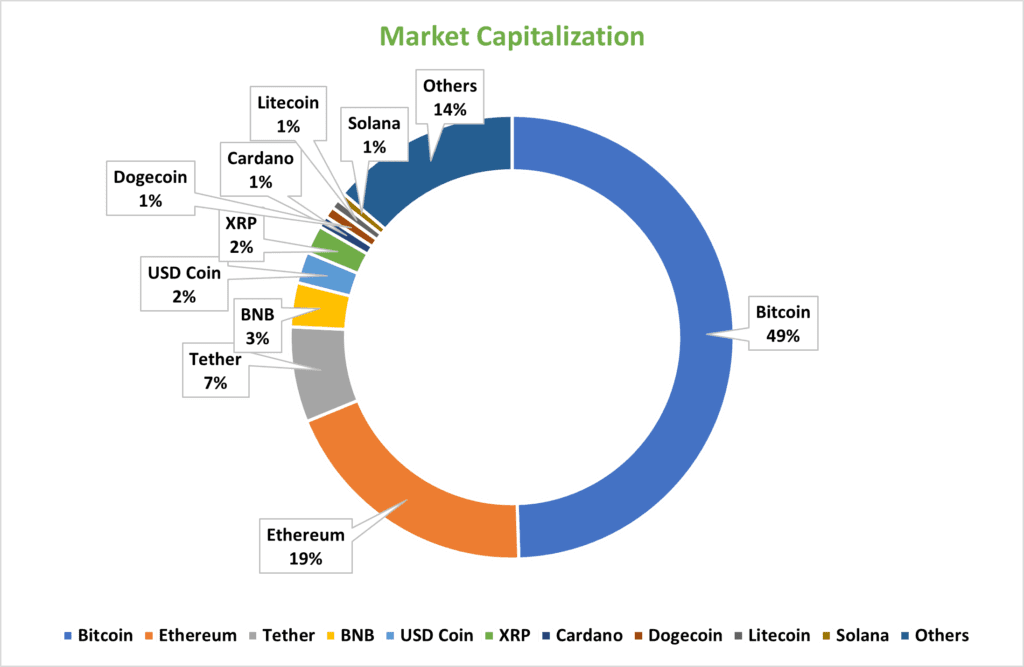

Photo by Moose Photos
Ethereum is an open-source blockchain platform that allows developers to build and deploy smart contracts and decentralized applications (dApps). It was created to expand upon the capabilities of traditional cryptocurrencies like Bitcoin by providing a programmable infrastructure that can execute code and enable complex transactions. Ethereum operates on its native cryptocurrency called Ether (ETH), which is used for transactions and as a form of digital asset. The platform has gained widespread adoption and is known for its versatility, enabling the development of various applications including decentralized finance (DeFi), non-fungible tokens (NFTs), and more.
Ethereum is the leading network for smart contracts and decentralized applications (DApps). Ethereum is gaining market share even when the market seems to be bearish. It’s market capitalization has increased from 18% to 20% in the past couple of years. Ethereum also has the highest total value locked (TVL) in smart contracts with $24.6 billion.
Despite the emergence of so many altcoins, Ethereum has been able to stay relevant throughout it’s existence. It not only existed but dominated the altcoins. And looking at the current scenario, it is only getting stronger.
Why Ethereum will continue to dominate in the coming years?
1. Ethereum ecosystem has the highest number of active developers
Ethereum has the highest number of active developers as it offers a flexible platform for creating a wide range of applications. It has a user-friendly programming language called Solidity and has a large and supportive ecosystem. Ethereum was one of the first platforms to introduce smart contracts, gaining early recognition and adoption.


- Ethereum has the highest number of active developers (Total developers 5758, Full-Time Developers 1976), which is more than the next three competitors (Polkadot, Cosmos, and Solana) combined.
- Ethereum has over 700,000 validators, with 99% of the balances locked in staking. Lido controls 32% of the staking, followed by Coinbase with 9.6%.
- Ethereum also has the highest ever number of new developers (14,691) in blockchain
- Ethereum accounts for 16% of all developers in the crypto space, with significant growth seen among full-time (9%) and part-time (7%) developers.
- The top 10 contracts on Ethereum, ranked by gas usage, indicate that DeFi and NFTs are the prominent use cases.
- Ethereum is less centralized in terms of development and validation compared to Tron, BNB Chain, and Solana.
Having such a large community of active developers provides a significant competitive advantage over the others. It helps drive innovation, expand the range of applications, enhance security, and ensure continuous development and improvement of the platform.
2. Ethereum remains the market leader in NFTs
Ethereum remains the biggest player in the NFT market. It was one of the first blockchains to introduce and popularize NFTs. It has a strong community of creators, collectors, and marketplaces built on its platform. Ethereum’s smart contract technology allows for the creation and trading of unique digital assets, making it a go-to platform for NFTs. Many popular NFT projects and marketplaces like CryptoPunks, Art Blocks, OpenSea, NBA Top Shot, etc. are already built on Ethereum, which attracts more people to buy and sell NFTs there.
- Ethereum had the highest NFT sales, accounting for over 63% of the total sales in June 2023, with $452 million.
- Bitcoin had the second-highest NFT sales, making up 15.6% of the total sales.
- Solana-based NFT sales saw a significant increase of 65% compared to the previous month, reaching $70.42 million.
- Mythos and Polygon were also among the top five blockchains for NFT sales, but both experienced declines in June compared to May.
3. Ethereum is still the world’s biggest smart contract blockchain
According to a study by Zion Market Research, the global smart contracts market was valued at approximately $1,750 million in 2022. It is expected to reach around $9,850 million by 2030, growing at an average annual rate of about 24% between 2023 and 2030. Ethereum has gained widespread adoption and has become the go-to platform for developers and businesses looking to create and deploy smart contracts.


- In 2022, Ethereum emerged as the leader in developing and processing smart contracts. It generated a revenue of $52.6 million, holding a market share of 36.3% in the smart contract space.
- Bitcoin ranked second in this segment, with a total value of $42 million during the same year.
Reasons why Ethereum is dominating the smart contract market:
- Ethereum was one of the first blockchains to introduce smart contracts. This early entry gave it a head start and allowed it to build a strong ecosystem and community around smart contracts.
- Ethereum has established standards for smart contracts, such as ERC-20 (for fungible tokens) and ERC-721 (for non-fungible tokens/NFTs). These standards enable compatibility and easy interaction between different projects and platforms, fostering collaboration and facilitating the creation of diverse applications.
- Ethereum’s dominance has created a network effect. As more users, developers, and projects join the Ethereum ecosystem, its value and utility increase. This makes Ethereum more attractive for new participants, further solidifying its position as the leading smart contract platform.
- Ethereum has a large and vibrant community of developers who actively contribute to the platform’s growth and innovation.
4. Ethereum 2.0: The Ethereum Merge
In mid-September 2022, Ethereum 2.0, also known as Ethereum’s Serenity upgrade, brings several important changes to make Ethereum better. Here are some key upgrades:
- Proof of Stake: Instead of using lots of energy to mine new coins, Ethereum 2.0 uses a method called Proof of Stake. This means people can validate transactions and create new blocks by holding and “staking” their coins as collateral.
- Shard Chains: Ethereum 2.0 divides the network into smaller parts called shards. Each shard can handle its transactions and smart contracts independently, making Ethereum faster and able to process more transactions at the same time.
- Beacon Chain: The Beacon Chain is like the boss of Ethereum 2.0. It keeps everything organized, manages validators, and stores important information about the network.
- Crosslinks and Finality: To connect the shard chains, Ethereum 2.0 uses crosslinks. These crosslinks contain summaries of data from each shard chain and help ensure that transactions are secure and can’t be changed.
- Improved Security and Efficiency: With Ethereum 2.0, the network becomes more secure because it’s harder for someone to control the network with a 51% attack. It also aims to be more efficient, so transactions can be faster and cheaper.
- Ethereum 1.x Integration: Ethereum 2.0 is designed to work together with the current Ethereum network. This means that existing applications and user balances can smoothly transition to the upgraded version.
5. Ethereum Goes Green for a Sustainable Future
One of the major concerns with Ethereum was the high power requirement. Before The Merge, Ethereum’s Proof-of-Work blockchain consumed a significant amount of electricity, comparable to Austria’s annual power usage. However, after the upgrade (Ethereum 2.0) both the electricity consumption and carbon footprint of Ethereum have decreased by over 99.9%, as reported by Digiconimist.
This move is seen as significant in attracting institutional endorsements for Ethereum and its cryptocurrency, Ether (ETH). Ethereum’s transition to PoS and its establishment of a low-emission infrastructure removes concerns about environmental impact, making it more attractive to institutional investors. This “Green ETH” narrative is expected to be a positive development in the history of cryptocurrencies.
What makes Ethereum better than others?
Ethereum’s pioneering role in smart contracts, established network and community, interoperability standards, decentralization, and rich ecosystem of developer tools set it apart as the leading blockchain platform.
Does Ethereum have a future?
Yes, Ethereum has a bright future ahead. It continues to be the leading platform for smart contracts and decentralized applications (DApps) and has a strong community, ongoing development efforts, and significant market adoption.
Who are Ethereum’s main competitors?
One of Ethereum’s main competitors in the blockchain space is Binance Smart Chain (BSC). BSC offers similar functionality to Ethereum, including smart contracts and decentralized applications, but with lower fees and faster transaction times. Other competitors include platforms like Solana, Cardano, Polkadot, and Tezos, which aim to address Ethereum’s scalability and cost issues.
Will Ethereum survive the competition?
Despite the rise of so many ‘Ethereum killers’, most experts believe Ethereum won’t disappear anytime soon. Being the first smart contract blockchain, it has a strong lead over its rivals. There is a large community of developers and validators on the Ethereum blockchain and Most cryptocurrencies in the Web3 ecosystem still use Ethereum.
However, Ethereum has problems with handling a large number of transactions which affects its scalability. Other competitor blockchains offer lower fees and faster transactions to attract users and developers. Despite Ethereum’s recent upgrade to PoS, the main Ethereum blockchain is still slower and more expensive compared to alternative blockchains.
Moreover, the introduction of blockchain interoperability by chains like Polkadot raises uncertainty about Ethereum’s ability to maintain its competitive advantage. Some cryptocurrency enthusiasts believe that interoperability is the future of Web3, which could result in Ethereum competitors gaining a larger share of the total value locked (TVL) in the market.
The future dominance of Ethereum as a smart contract blockchain will largely depend on the success of its recent upgrades.
Conclusion:
To wrap up, Ethereum has a bright future ahead. As the top platform for smart contracts and decentralized applications, it is well-positioned to maintain its dominance in the crypto world. With a strong community, ongoing development, and solutions to scalability challenges, Ethereum is poised for growth. It will continue to shape the future of finance and digital assets, making it an essential player in the evolving blockchain landscape.








